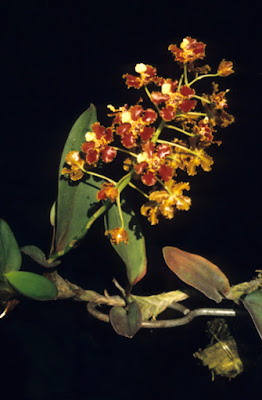Otoglossum coronarium is found in Colombia, Ecuador and Peru. It grows on steep banks in cloud forests at elevations of 1500 to 1600 meters above sea level.
Otoglossum coronarium also called as The Wreath-Shaped Otoglossum, Odontoglossum coronarium, Odontoglossum coronarium var. flavum, Oncidium coronarium, Otoglossum coronarium f. flavum, Otoglossum coronarium var. flavum, is a species of the genus Otoglossum. This species was described by Leslie Andrew Garay & Galfrid Clement Keyworth Dunsterville in 1976.
IDENTIFY OTOGLOSSUM CORONARIUM ORCHID PLANT
Otoglossum coronarium is found in Colombia, Ecuador and Peru. It grows on steep banks in cloud forests at elevations of 1500 to 1600 meters above sea level.
It is a miniature sized, cool growing epiphyte or terrestrial with ovate, laterally compressed, shallowly longitudinally grooved, 10 cm long pseudobulbs enveloped basally by several distichous, overlapping leafless and leafbearing sheaths and carrying a single, narrowly elliptical to oblong, thin, channeled above, keeled below, acute, gradually narrowing below into the petiole base, 30 cm long leaf.
The Wreath-Shaped Otoglossum blooms in the winter on an axillary, erect, stiff, to 50 cm long, 7 to 13 flowered inflorescence and carrying closely spaced, very showy flowers. Sepals and petals equal, subrotund, unguiculate, smooth, with their margins crisp or curled, about an inch long, of a rich reddish coppery brown on the upper surface, shining as if they had been varnished, yellowish underneath. Lip yellow, retuse, about same length as the petals, obovate, rounded at apex, narrowed and wedge-shaped at the base, where the sides arrange themselves into two narrow blunt falcate horns which are united on the under side. Crest consisting of three processes. Column slightly curved with two truncate rounded wings.
OTOGLOSSUM CORONARIUM ORCHID PLANT CARE AND CULTURE
Cultural information should only be used as a guide, and should be to be adapted to suit you. Your physical location; where you grow your plants, how much time you have to devote to their care, and many other factors, will need to be taken into account. Only then can you decide on the cultural methods that best suit you and your plants.
Light:
Otoglossum coronarium need a light level of 10000-15000 lux for mature plants, but less for young plants and when temperatures are high (70% shade cloth over summer and more light in winter). Leaves turn reddish blue if receiving too much light and leaf loss will occur if too sun damaged. Dark green leaves indicate insufficient light. A slight bronzing of the leaves and older bulbs indicates the light is good for flowering.
Temperature:
The Wreath-Shaped Otoglossum should be grown under cool temperature conditions. In summer, the optimum temperature range is between 8°C and 26°C. In winter, it need a minimum nighttime temperature of 7 to 12°C, with daytime temperatures of 10 to 17°C. The diurnal difference between day and night is usually 8 - 10°C. In their natural environment night temperatures can fall to 5°C and although tolerant of low temperatures down to 0°C, they will not tolerate frosts.
Humidity:
This orchid prefer humidity levels between 55-75%; higher levels of 60-80% require good air movement especially in the cooler months. Plants can also tolerate humidity levels down to 40% which can be maintained or increased with morning and evening misting.
Substrate, growing media and repotting:
Otoglossum coronarium are usually grown in pot using small bark (5-10mm) perlite potting mix (5:1) or in sphagnum moss and perlite (70:30) as substrate. Some growers place a layer of sphagnum moss on the top of the pot to reduce evaporation and keep the roots cool. They can also be grown in perlite with a layer of gravel on the top.
These plants should be repotted every year to every 2 years in spring or autumn when new growths are about half mature. They should be grown in small squat pots that allow more frequent watering. The base of the new growth should be planted about 1.5cm into the bark but no deeper. Keep bark barely moist until new roots appear then resume normal watering.
Watering:
The Wreath-Shaped Otoglossum like abundant water and require frequent watering in warmer months. They must never be allowed to dry out. During summer irrigation will be required every 2 -3 days, however during winter rates may drop to once every 10 – 14 days. Misting daily in very hot weather is recommended. To reduce leaf spotting, avoid watering in the heat of the day or late afternoon in warmer months. Also avoid wetting the leaves and water the pot, not the leaves.
Fertilizer:
This plant require frequent application of half to quarter strength fertilizer all year round but less in winter. Apply fertilizer every 2 weeks when growing actively but monthly when less active. They are not gross feeders and too much fertilizer will harm their roots and turn leaf tips brown. Use of high phosphorus or potassium fertilizers as plants approach flowering can increase flower count and substance.
Rest period:
Otoglossum coronarium do not a rest period to stimulate flowering nor in winter. But they need less water in the winter, especially if they grow under the conditions of a dark, short day that occurs in moderate latitudes. You can let the plants dry between the next watering, but you must not let the plants stay dry for a long time. Fertilization should be limited or should be completely abandoned until spring, when stronger watering resumes.















COMMENTS